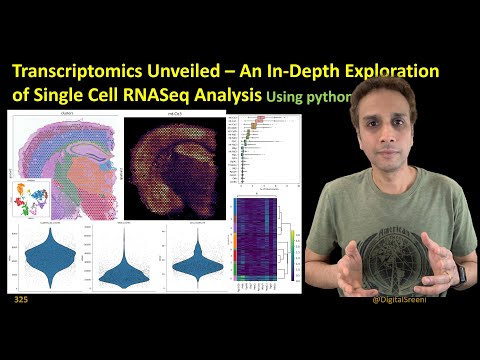325: Transcriptomics Unveiled – An In-Depth Exploration of Single Cell RNASeq Analysis using python
Code generated in the video can be downloaded from here: https://github.com/bnsreenu/python_for_microscopists/blob/master/325_Transcriptomics_Unveiled.ipynb
Dataset from: https://cell2location.cog.sanger.ac.uk/tutorial/mouse_brain_visium_wo_cloupe_data.zip
Useful resources:
mRNA-Seq whole-transcriptome analysis of a single cell: https://www.nature.com/articles/nmeth.1315
A practical guide to single-cell RNA-sequencing for biomedical research and clinical applications: https://genomemedicine.biomedcentral.com/articles/10.1186/s13073-017-0467-4
An introduction to spatial transcriptomics for biomedical research: https://genomemedicine.biomedcentral.com/articles/10.1186/s13073-022-01075-1
Spatially resolved, highly multiplexed RNA profiling in single cells: https://www.science.org/doi/10.1126/science.aaa6090
Comparative analysis of MERFISH spatial transcriptomics with bulk and single-cell RNA sequencing: https://www.biorxiv.org/content/10.1101/2022.03.04.483068v1
Spatial omics technologies at multimodal and single cell/subcellular level: https://pubmed.ncbi.nlm.nih.gov/36514162/
Description:
The DNA sequence is the same in almost all cells of a given type of organism (Genome). DNA sequence of an organism’s genome contains the instructions necessary for development, functioning and maintenance of that organism. For a specific organism (e.g., Mouse), the DNA sequence is generally consistent across different cells within that organism. Every cell in the mouse’s body contains the same set of genes with the same DNA sequence. However, cells may have specific (combination of) genes turned on or off, making them perform their specific function – gene expression or gene regulation. Different cell types have specific gene expression profiles (e.g., genes involved in muscle contraction will be turned on in muscle cells and not in skin cells). Cellular diversity and cell-specific function is best assessed not at the DNA level, but at the protein level. However, there are no commercially available methods for quantifying the thousands of proteins within individual cells of our bodies. In 2009 the first description came for entire mRNA (~20,000 genes) from a single cell, known as the transcriptome – which opened doors to transcriptomics.
Why study RNA?
Studying RNA can provide insights into which genes are turned on (expressed) or off (not expressed) in a given cell as:
– RNA molecules are synthesized from DNA templates.
– analyzing RNA in a cell can provide information on which genes are actively being transcribed, hence expressed.
RNA Sequencing allows researchers to determine the identity and abundance of different RNA molecules, including messenger RNA (mRNA) transcripts
By comparing the RNA-seq data across different samples or conditions, researchers can identify which genes are upregulated (turned on) or downregulated (turned off) under specific circumstances.
What is scRNA-seq?
scRNA-seq permits comparison of the transcriptomes of individual cells to assess transcriptional similarities and differences within a population of cells and to identify rare cell populations that would otherwise go undetected in analyses of pooled cells. It can also help in tracing lineage and developmental relationships between heterogeneous, yet related, cellular states in scenarios such as embryonal development, cancer.
Why spatial transcriptomics?
Sc-RNA Seq is good but comes with a requirement of liberating viable cells from whole tissue without inducing stress, cell death, and/or cell aggregation. But in spatial transcriptomics methods, spatial information is preserved by studying intact tissue.
Data processing:
For all techniques, including Visium, Slide-seq, SeqFISH, MERFISH, and Drop-seq, the end result is a table that represents the gene expression profiles of individual cells.
The table typically consists of rows representing individual cells or spatial locations within the tissue and columns representing genes. The values in the table correspond to the gene expression intensities or counts for each cell or location.
Downstream analysis includes, quality control, dimensionality reduction, clustering, differential expression analysis, cell type identification, spatial analysis, and visualization.
These analyses help extract biological insights and understand the cellular composition, heterogeneity, and spatial organization within the tissue.
source



